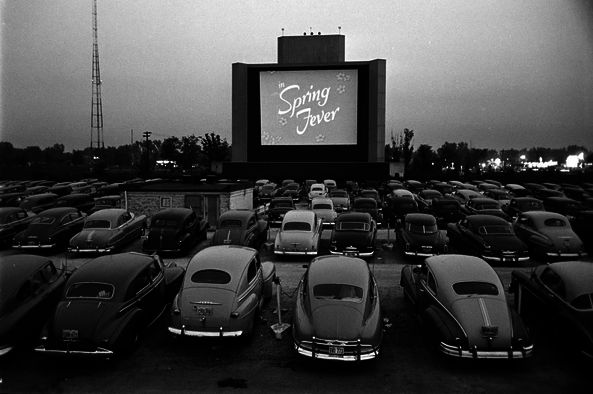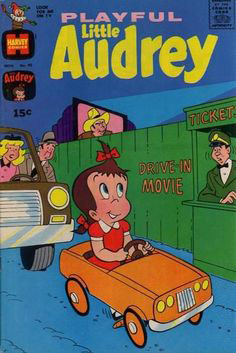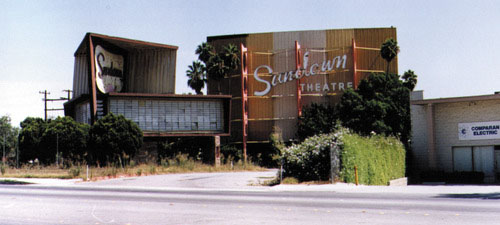
Movie theaters for African American audiences were second-run facilities during the era of legal segregation. These venues exhibited films–including cartoons–after European Americans saw them in first-run theaters, but “colored only” theaters were not the only second-run options. Many exhibitors, especially at drive-in theaters, opted to show older films for lower rental fees, and they charged patrons lower admission fees than the first-run places did. Nevertheless, under Jim Crow, second-run status was mandatory–not an option–for African American theaters like the Sundown Drive-In of Greensboro, North Carolina. African Americans Rounder L. Ledwell and Clarence L. Fuller co-founded the theater and operated it from 1950 to 1966.
A study of the film bills for Sundown in local newspapers Greensboro Daily Times and Greensboro Record shows how an African American theater responded to segregation and changes in the film industry when booking cartoons. Sundown was one of very few theaters–regardless of the audience’s skin color–to announce cartoons accompanying features in print continuously for sixteen years, especially during the 1950s and ’60s. The venue rarely exhibited a cartoon within one year after its release but rather typically presented films that had already circulated for one or two years in other places.
 The theater’s avoidance of gimmicks like CinemaScope was practical, for such fads usually passed their peak by the time the films exploiting them reached the drive-in. Sundown also proved risk-averse by booking cartoons starring popular, established stars instead of experimental one-shot films. For example, the theater did not show any of the experimental “Jolly Frolics” episodes (1949-53) from United Productions of America (UPA) until distributor Columbia Pictures reissued them as part of the “Favorites” series in the 1960s. To an extent Ledwell’s and Fuller’s tactics worked. Sundown survived as countless theaters succumbed to competition from television, and it stuck to cartoons as animation studios, closed, reopened and closed again.
The theater’s avoidance of gimmicks like CinemaScope was practical, for such fads usually passed their peak by the time the films exploiting them reached the drive-in. Sundown also proved risk-averse by booking cartoons starring popular, established stars instead of experimental one-shot films. For example, the theater did not show any of the experimental “Jolly Frolics” episodes (1949-53) from United Productions of America (UPA) until distributor Columbia Pictures reissued them as part of the “Favorites” series in the 1960s. To an extent Ledwell’s and Fuller’s tactics worked. Sundown survived as countless theaters succumbed to competition from television, and it stuck to cartoons as animation studios, closed, reopened and closed again.
Sundown opened in June 1950, and its first season of cartoons set the template for what followed for the next sixteen years.
The theater presented “Noveltoons” from Paramount Pictures, new cartoons and “Blue Ribbon” reissues from Warner Brothers, new cartoons and “Gold Medal” re-releases from Metro-Goldwyn-Mayer (MGM), and new Disney cartoons. The managers chose the series with the most popular cartoon stars, and they chose older films that had already scored well with audiences. Sundown also showed cartoons starring “mammy” characters from MGM and Paramount.
Ledwell and Fuller appeared to prefer cartoons featuring caricatures of African Americans. Civil rights organizations and crusaders against ethnic stereotypes protested the releases of such films, but Sundown’s booking of the cartoons revealed differences in tastes between African Americans in the Jim Crow South and northern-based activists. Members of the National Association for the Advancement of Colored People protested films starring the “mammy” caricatures in “Tom and Jerry” and “Noveltoons” starring Little Audrey, but Sundown’s offerings for 1950 included the former’s The Lonesome Mouse and the latter’s Butterscotch and Soda.
The drive-in also booked Paramount’s cartoons starring the black crow Buzzy (1947-54) as late as 1960, and the “Tom and Jerry” maid’s last appearance there was in 1961–eight years after the debut of her final episode. In addition, the venue presented Metro-Goldwyn-Mayer’s reissue of Uncle Tom’s Cabana in 1955, despite efforts by the African American newspaper Pittsburgh Courier to remove the film from theaters during the previous year.
In the early and mid-’50s, Sundown remained committed to animation from Paramount, Warner Brothers, MGM, and Disney. The theater added Paramount’s “Popeye” series and Warners’ “Bugs Bunny Specials” during this time. In addition, Sundown began accepting films from other distributors but only if they were popular. Episodes of UPA’s star Mister Magoo and Universal-International’s Woody Woodpecker appeared at the drive-in, and Terrytoons sporadically graced the screen.
 Then suddenly the film industry’s embrace of CinemaScope in the late ’50s initiated major changes at Sundown. Animation studios Disney, MGM, and UPA released their films in the wide-screen process, but the drive-in did not invest in the trend. Instead, Sundown stopped exhibiting new cartoons from those studios. The theater booked more “Blue Ribbons,” “Gold Medals,” and “Favorites” episodes, and it even took chances on unproven new characters such as Columbia’s French wolf Loopy de Loop and Paramount’s duo Jeepers and Creepers. By the ’60s the drive-in showed about as many reissues as new cartoons.
Then suddenly the film industry’s embrace of CinemaScope in the late ’50s initiated major changes at Sundown. Animation studios Disney, MGM, and UPA released their films in the wide-screen process, but the drive-in did not invest in the trend. Instead, Sundown stopped exhibiting new cartoons from those studios. The theater booked more “Blue Ribbons,” “Gold Medals,” and “Favorites” episodes, and it even took chances on unproven new characters such as Columbia’s French wolf Loopy de Loop and Paramount’s duo Jeepers and Creepers. By the ’60s the drive-in showed about as many reissues as new cartoons.
The decrease in new available cartoons during this time also resulted from fewer releases from the animation studios themselves. UPA and Disney stopped making films for theaters, and MGM and Warners closed their cartoon units. As booking options for new product dwindled, Sundown showed more “Cartunes” and added Paramount’s “Modern Madcaps” and “Swifty and Shorty” to its roster. The theater also exhibited multiple episodes of Gene Deitch’s “Tom and Jerry” revival. However, not all new versions of old series appealed to Sundown’s managers; they declined to play any of DePatie-Freleng Enterprises’ cartoons for Warners.
The Civil Rights Act of 1964 made segregation illegal, and Greensboro’s “whites only” theaters now had to welcome African Americans. Sundown survived the new law’s passage by only two years. For the final season–1966–the theater offered new episodes of “Loopy de Loop,” “Cartunes,” “Modern Madcaps,” “Swifty and Shorty,” “Terrytoons” (Duckwood, Astronut, and Luno), and Chuck Jones’s “Tom and Jerry” revival. Among the reissues were “Favorites,” “Gold Medals,” and Disney cartoons. DePatie-Freleng’s “Pink Panther” was in its second season, and “The Inspector” had just begun. However, Sundown remained one to two years behind in exhibition and did not show cartoons from either series. After sitting out the 1967 season, the drive-in folded the following year.
Sundown’s commitment to animation outlasted many of those from its “white only,” “colored only” and integrated competitors across the country. The theater survived by catering to a specific market, albeit by law, and it strategically booked popular second-run cartoons in order to attract audiences. It was not a trend-setting or experimental facility, and it took few risks in avant-garde exhibitions. It ignored growing public concerns about ethnic stereotyping and highlighted cartoons with African American protagonists. By remaining practical and creatively conservative, Ledwell and Fuller successfully navigated through theatrical animation’s twilight.

Author’s Postscript: I was able to research the Sundown Drive-In via listings in digital archives of local newspapers posted at genealogybank.com. On that website, most of the listings for the Sundown – placed in the Greensboro Record and the Greensboro Daily News – had the title to a cartoon. The Sundown never announced which character starred in a cartoon; it only had the cartoon title.


 Christopher P. Lehman is a professor of ethnic studies at St. Cloud State University in St. Cloud, Minnesota. His books include American Animated Cartoons of the Vietnam Era and The Colored Cartoon, and he has been a visiting fellow at Harvard University.
Christopher P. Lehman is a professor of ethnic studies at St. Cloud State University in St. Cloud, Minnesota. His books include American Animated Cartoons of the Vietnam Era and The Colored Cartoon, and he has been a visiting fellow at Harvard University.



























It is rather ironic that Walter Lantz/Universal-International, like UPA, wasn’t represented here as much as other companies. Although that studio occasionally gets chewed out by contemporary historians for Lil’ Eightball and SCRUB ME MAMA WITH A BOOGIE BEAT, the primary racial stereotypes after 1943 or so were Native Americans going “ugh”. Maybe some of the Mexican themed films were questionable as well. Then again, the popularity of Tom & Jerry’s Mammy indicates that any “representation” is better than no representation at all. You can’t have every human character be Caucasian on screen. Cartoons are lucky in that so many characters are non-human and beyond any racial issues unless Bugs Bunny mimics Al Jolson’s blackface routine and pretends to be a slave in SOUTHERN FRIED RABBIT. By the way, was that title included in any of the theatrical showings?
I did not see a listing for SOUTHERN FRIED RABBIT when I looked just now.
There isn’t much that is disturbing in that particular title, but Yosemite Sam is too pro-Confederate for comfort. Titles with Sam as an Arab or a Roman gladiator would have been favored… obviously. Then again, it may have just been a coincidence that it wasn’t included.
I love your posts! This is such an interesting take on an overlooked corner of history. Keep up the great research!
Thank you! My research on this particular article really revealed a lot to me on what I thought I’d already known.
If the operators of the Sundown Drive-In went out of their way to book cartoons with African-American characters–stereotyped though they may have been–it shows once again the divide that exists between activists on the one hand, and the people they purport to represent on the other.
But this was not a new phenomenon then, nor is it extinct today.
In the early 1930’s, activists from the NAACP protested the popular “Amos ‘n’ Andy” radio show, which was a serialized comedy-drama at the time. Yet that was the most popular program in Harlem, on the South Side of Chicago, and in other “Bronzevilles” across the urban North-East.
The people in these neighborhoods saw “Amos ‘n’ Andy” as a slice of urban Black life–especially in the days before the show became a half-hour situation comedy (in 1943).
In more recent years, Cartoon Network has tried to suppress the “Speedy Gonzales” cartoons–only to ind out that there was a tremendous demand for them in Mexico and throughout Latin America. This was as surprising to the CN people as it must have been disheartening to the “La Raza” activists.
“Buzzy the Crow” was designed to capitalize on Jackson Beck’s impression of Eddie “Rochester” Anderson, who was the highest-paid Black entertainer of his day. The usual plot had Buzzy–a canny character of color–putting it over on a brains-deficient ofay cat. In one respect, these cartoons are urban versions of tales of “the trickster”–a character found in may Central African folk-tales, and a template for Joel Chandler Harris’s “Uncle Remus” stories.
Anderson was criticized in his day by some vestigial Ku Klux Klan-type groups for being too “uppity” in his Rochester character. He also got it from the NAACP, who saw him as just another servile Uncle Tom.
That he got criticized from both sides might suggest to some that he was doing something right!
You’re right that Sundown is not unique in accepting Hollywood’s African American fictional characters of the day. African Americans of this era later told me that they were amused by AMOS ‘N’ ANDY in their own homes, but they were upset that some European Americans assumed that all African Americans spoke like the radio characters and were as gullible as Andy or conniving as Kingfish.
If SPeedy Gonzales were to be allowed only for Sylvevester and other Pre-Daffy villians—–Daffy and Speedy, a very odd “X vs Y” teaming—–that would be totally sufficent for me!
Totally off topic, but this 1983 documentary is a fun watch: https://www.youtube.com/watch?v=8Ka6u2WA_zU
My dad’s favorite show, Lewis!
Great post, Christopher! Here’s another interpretation of “Sundown” Drive-In theaters; cartoons sometimes were referred to as “sundowners” by Drive-In proprietors, especially here in Southern California. That’s because they could show cartoons before the sun was fully down and the “serious” feature picture came on. After all, the colors in most cartoons were pretty bright and show to OK advantage even with some light still in the sky. Also cartoons like Terrytoons were perceived as entertaining only to the children, and they wouldn’t mind seeing the cartoons early.
Thank you, Mark! That interpretation of “Sundown” explains a lot, actually, because I’ve started to notice multiple drive-ins named “Sundown” in my research.
Amusingly, one that is still left in my area is called “The Sundance”! It used to be “The Sundance Kid Drive-In”, as there was another drive-in in another part of town called “Butch Cassidy”.
The drive-in here in my home town was called the Stardusk. It closed in the 80’s and is a housing tract now, called Stardusk Estates. Due to the long, cold Wisconsin winters, it only operated from about April thru October, and was closed the rest of the year. Not sure what they showed for cartoons, but in my museum job I recently uncovered a 10-minute 35mm promotional short sent to them around 1980 as a freebie by the US Air Force. It still had a cover letter AND a folded one-sheet inside the shipping case!